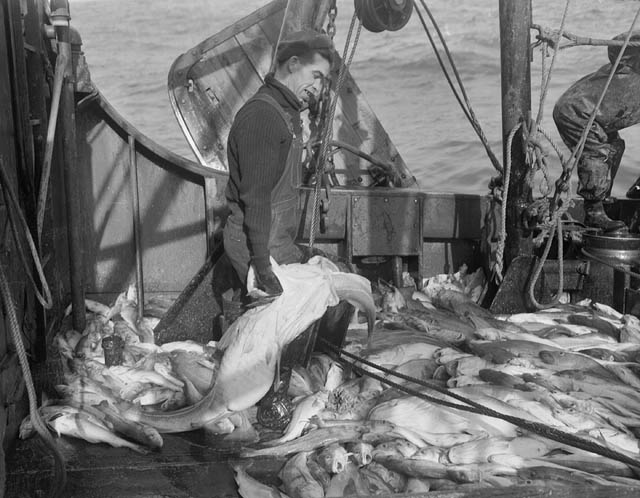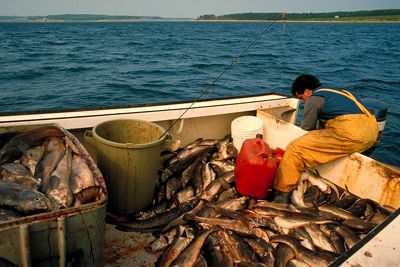On 2 July 1992, the federal government banned cod fishing along Canada’s east coast. This moratorium ended nearly five centuries of cod fishing in Newfoundland and Labrador. Cod had played a central role in the province’s economy and culture.
The aim of the policy was to help restore cod stocks that had been depleted due to overfishing. (See also Fisheries.)
Drying Codfish
Stereoscopic image showing fishermen laying out cod in piles to dry at Battle Harbour, on the Labrador coast, c. 1900.
(photo by Keystone View Company/Graphic House/Archive Photos/Getty Images)
Early Cod Fishing off Newfoundland
The lndigenous peoples of what is now Newfoundland did some fishing. But these peoples, including the Dorset and Beothuk, mainly used the ocean to hunt seals, seabirds and shellfish.
Most large-scale fishing activity developed after John Cabot’s voyage of 1497. Cabot’s crew reportedly claimed that there were so many cod around Newfoundland that one could catch them simply by lowering a basket into the water. By the mid-1500s, fishing vessels from Britain, France, Spain and Portugal regularly crossed the Atlantic to fish for cod. North Atlantic cod — salted and dried for preservation — accounted for more than half of all the fish eaten in Europe. The seasonal fishing outposts Europeans used gradually became permanent settlements.
Fishing practices remained largely unchanged for the next several centuries. Gradually, however, a local, inshore fishing industry grew up alongside international offshore fishing.
Modernization and Overfishing

After the Second World War, there were major advances in fishing technology. These advances included better nets and sonar for finding fish. New “factory freezer” trawlers could stay at sea for months at a time. With these new tools, it was possible to catch many more fish. On the Grand Banks, the main fishing zone off Newfoundland, the groundfish catch steadily rose. Most of this catch was cod. The yield peaked at 810,000 tons in 1968. Later estimates suggest that the harvestable biomass of cod (fish large enough to be caught and eaten) dropped by 82 per cent between 1962 and 1977.
On 1 January 1977, Canada extended its fishing limits to 200 nautical miles (370 km) off its coast. (See History of Commercial Fisheries.) This was partly a measure to reduce foreign fishing of cod. Overall catches did drop briefly as foreign boats left the area. But the new rules did little to prevent Canadians from catching more and more in waters where they alone now fished. Newfoundland’s cod industry grew markedly thanks to the new rules. In 1975, the province had 15,000 fishers and 110 fish processing plants. By 1980, it had 35,000 fishers and 175 processing plants.
It was the job of scientists at the Department of Fisheries and Oceans (DFO) to estimate the amount of cod being caught. In the 1980s, these scientists arrived at their estimates through a flawed process. As a result, they set quotas that were too high to make the fishery sustainable. Government officials also often raised these quotas to sate economic needs. In 1986 or 1987, the Newfoundland Inshore Fisheries Association (NIFA) commissioned a report on the DFO’s estimates. The report suggested that the DFO was overestimating the number of cod left by more than 100 per cent. The NIFA launched a lawsuit that sparked an internal review at the DFO. In 1989, the internal review confirmed the findings of the NIFA report. This prompted scientists to recommend a 50 per cent reduction in quota levels. The federal government ignored the recommendation.

The Moratorium and its Effects
By 1992, the spawning biomass stock (individuals of breeding age) of northern cod had fallen to just 1 per cent of its estimated peak. Fisheries and Oceans minister John Crosbie responded to the clear evidence of decline. He announced a two-year moratorium on cod fishing on 2 July. Protesters who opposed the ban tried to break into the room where the news conference was held. The previous day, they had also confronted Crosbie in the streets of Bay Bulls, Newfoundland.
The government later extended the ban with no end date in sight. It made an exemption, though, for a small stewardship fishery.
The moratorium was the largest layoff in Canadian history. It affected some 40,000 fishers and related workers. In Newfoundland and Labrador alone, nearly 30,000 people lost their jobs. The government introduced the Northern Cod Adjustment and Recovery Program (NCARP). Through NCARP, workers received employment insurance payments and retraining. They largely viewed it as inadequate, however. Newfoundland and Labrador’s population dropped by 10 per cent in the first decade of the ban as people left the province for lack of work. (See also Unemployment in Canada.)
Unable to pursue cod, the fishing industry turned to shellfish, particularly snow crab and lobster. This offset some of the financial impacts. But the province’s fishing industry has still never recovered to the heights of the mid-1980s. (At that time, cod alone were worth about $700 million to the economy and Canada was the largest exporter of seafood in the world.) In the early 2000s, scientists began warning that snow crab stocks were showing signs of decline. In 2017, the DFO announced the snow crab population had declined by more than 80 per cent in less than four years.
In 2008, scientists noted the first substantial increase in cod since 1992. Some research published in 2015 suggested northern cod may finally be making enough of a recovery to end the moratorium. Acting on this research, policy-makers raised stewardship quotas. Between 2017 and 2018, however, the stock dropped by as much as 30 per cent.
In 2024, the Government of Canada announced the return of the commercial cod fishery in Newfoundland and Labrador. The total allowable catch (TAC) for the 2024 season was set at 18,000 tonnes. In 2025, the TAC was increased to 38,000 tonnes with the DFO noting that Northern cod stock “has been generally stable since 2017.” These changes have drawn criticism from some scientists who have voiced concerns about cod stock and sustainability.

 Share on Facebook
Share on Facebook Share on X
Share on X Share by Email
Share by Email Share on Google Classroom
Share on Google Classroom










